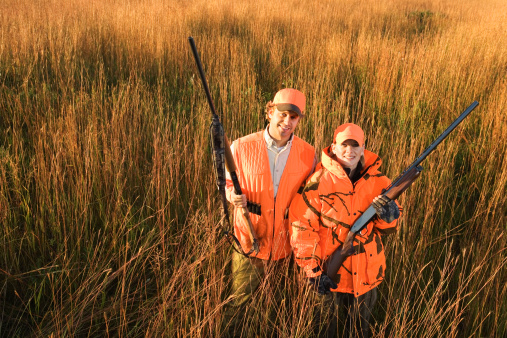A visit to Brockport helps scientists developing robotic guide dog
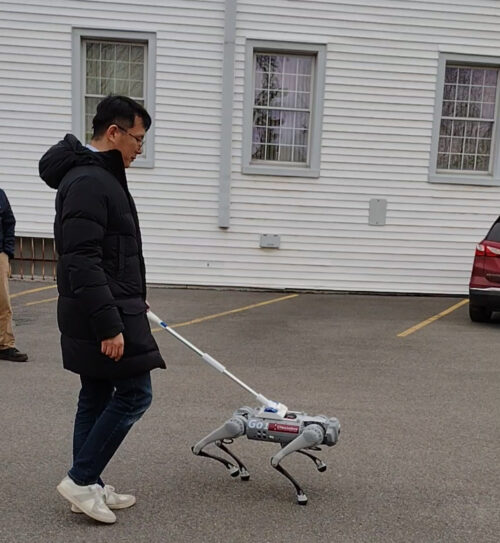
by Kelly Jo Stone,
Freedom Guide Dogs for the Blind
On a rainy spring day, two men climbed from their car. We excitedly waited in the parking lot for them to approach. Freedom Guide Dogs for the Blind has been training and placing guide dogs since its inception in 1992 by Eric and Sharon Loori. Their organization has several trainers, including Guide Dog Mobility Instructor Jeff Butterman who resides in the Rochester area. That instructor and the promise of blindfolded walks had drawn Donghyun Kim, a faculty member and Advisor of the Manning College of Information & Computer Sciences, and Hochul Hwang, a Ph.D. student, both from the University of Massachusetts. The guide dogs in training waited patiently in a van nearby.
With handshakes and introductions completed, the astonishment began. They pulled an innocuous case from their trunk, laying it on the ground at our feet. We waited with held breath as the lid opened to reveal the robotic guide dog inside. They had created a quadrupedal robot that will eventually help blind and visually impaired individuals navigate through difficult environments, just like a guide dog.
While their prototype for a robotic guide dog is still in the initial stages, their research required a walk with an actual guide dog. We watched in awe as the dog slowly came to life, rising from its folded position and unfolding into a metallic canine replica.
Butterman was eager to try the robotic dog, and they granted his wish in mere moments. He found himself led in circles with his hand on the handle. The robot marched around the parking lot with high, rhythmic steps. What a sight it must have been, the parking lot damp with falling rain, cars sporadically parked, and four people with their attention focused on a small robot.
As we spoke, asking and answering questions, we learned that their hope was that the robot world would someday integrate on a user-friendly basis into the guide dog community, offering another route for those in need of a guide dog. Strides to ensure the ability of robots to interact with the guide dog community are underway. The UK charity Guide Dogs and the autonomous delivery robot company Starship Technologies conducted a pilot study on how guide dogs respond to autonomous delivery robots. The study involved guide dogs accompanied by their owners or trainers out on their regular everyday activities, encountering Starship delivery robots along the way.
Additionally, there are portable handheld devices that guide users through outdoor and indoor obstacles using a special control gyroscope device that moves users’ hands. But the robotic guide dog we watched move around the parking lot that day was a replica of a dog – offering a future user the instant recognition of being a guide dog user without the responsibility of caring for a live animal.
As we stood discussing the endless possibilities, their eyes repeatedly strayed to the red van that sat just steps away. Then it dawned on us that these two scientists were just as eager to see the real dogs as we had been to see the robot.
A blindfold walk consists of donning a blackout blindfold and allowing a guide dog to lead you on a walk. Those who live in the Rochester area may have witnessed the odd sight of a blindfolded person walking with a dog in harness. The experience is overwhelming, intimidating, enlightening, and humbling. And for these two scientists necessary, you see; creating a robotic guide dog in form is only one part of the equation.
A guide dog in harness has a very particular set of standards. The research allowed consideration of the harness, its placement in the hand, and necessary adjustments for height and angles. But additionally, research on the ratio of force versus pull. There can be no guesswork as the robot will lead a living person. The scientists explained all of this, and we nodded as if we understood. Still, throughout the day, I had small flashes of having been dropped into an episode of the television sitcom “The Big Bang Theory.”
After introductory sniffs and kisses, they were ready. They traversed the streets of Brockport several times with different guide dogs.
Each dog has its own traits, quirks, and strengths. Hochul Hwang and Donghyun Kim excitedly experienced them all. They expressed their surprise at the combination of subtle and clear guidance of the dogs as they led them down the sidewalk and across the streets. After more than an hour, we had done all we could do on the streets of the Village of Brockport.
However, questions remained, so we moved our adventure to the local Lowes. We watched in fascinated awe as electronic equipment was attached to link them and the harness. Scientific jargon danced around my ears.
While I understood the concept of needing to know how much pull the dog issued to guide a user around and through obstacles, the conversation was lost on me as they spoke of converting the data into graphs and measurements.
After several walks around the store, we found ourselves staring mesmerized as they produced a laptop and excitedly began exclaiming over the initial results. I looked around; here were these two brilliant minds with a laptop set up on the end of a tractor, and birds were chirping overhead. Their minds were working at a speed that I frankly envied.
I scratched the top of the guide dog’s head and glanced down. The yellow lab looked up at me with a magnificent, happy, doggy grin. His eyes were alight with happiness, and it occurred to me that the experience had been just as odd and amazing for them.
Provided photos
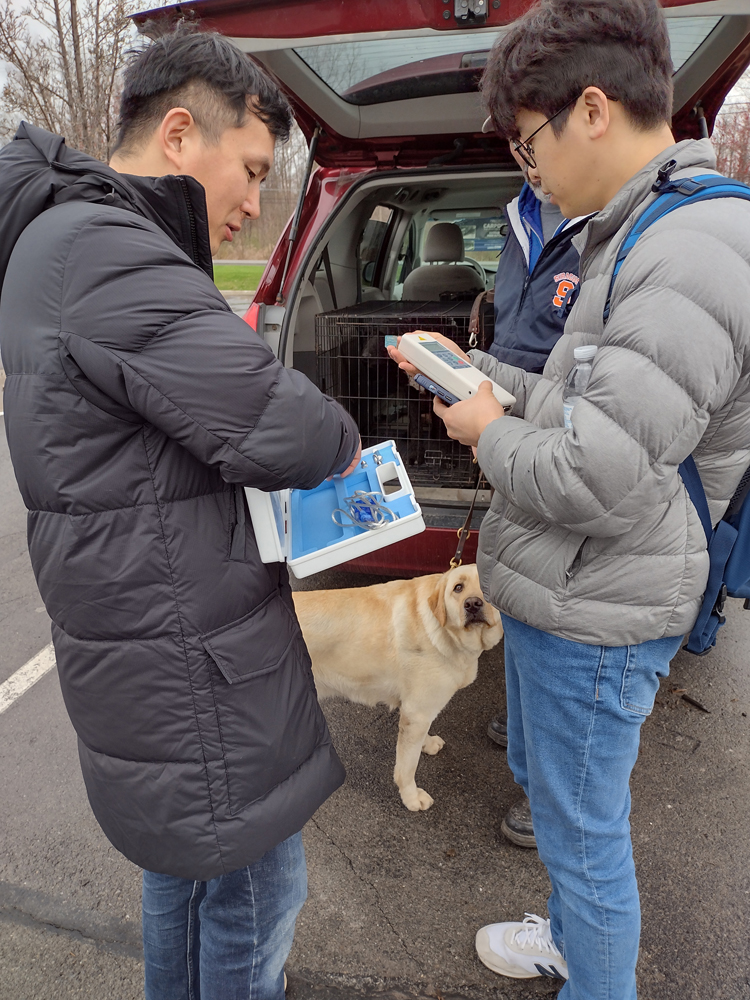
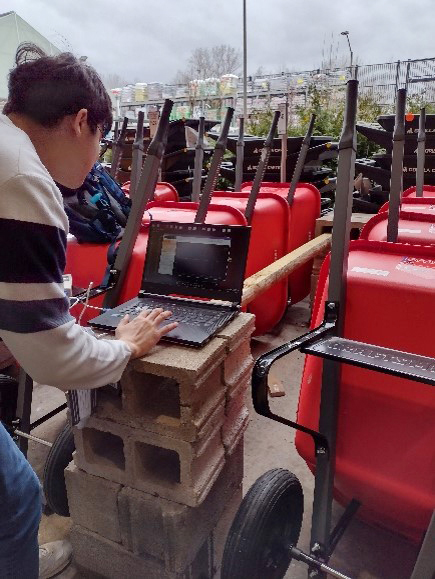
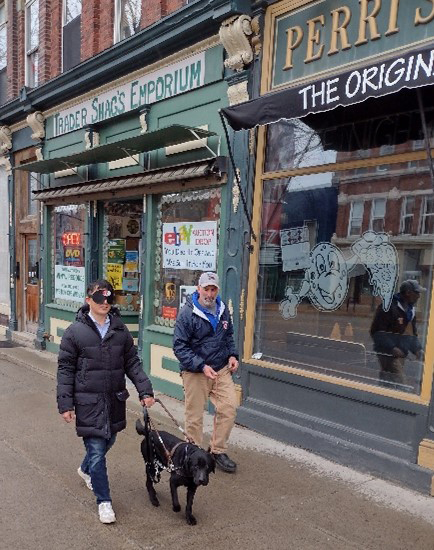
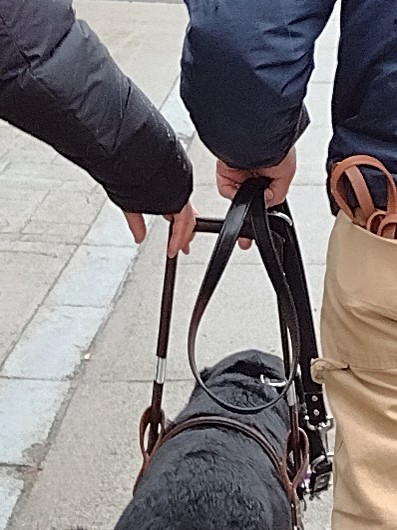
Part of the walk included learning the nuances of the harness.




